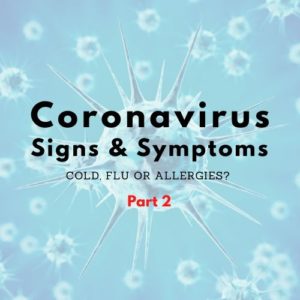COVID-19, Cold, Flu or Allergies? – Part 2


This is a link to Part 1: Cold, Flu, Allergies or Coronavirus?
Symptoms of COVID-19
As COVID-19 is a brand new disease caused by a brand new virus, the list of symptoms is a bit longer as we do not have a grasp on what is “typical” for this disease. Fever, dry cough and respiratory symptoms are the most common. Fatigue is fairly non-specific.
According to the World Health Organization (WHO) report on COVID-19, the typical signs and symptoms include:
- Fever (87.9%)
- Dry Cough (67.7%)
- Fatigue (38.1%)
- Sputum production, which is a mixture of saliva and mucus coughed up (33.4%),
- Shortness of breath (18.6%)
- Sore throat (13.9%)
- Headache (13.6%)
- Muscle and joint pain (14.8%)
- Chills (11.4%)
- Nausea or vomiting (5.0%)
- Nasal congestion (4.8%)
- Diarrhea (3.7%)
- Coughing up blood (0.9%)
- Conjunctival congestion (0.8%)
The WHO report also said people with COVID-19 generally develop signs and symptoms, including mild respiratory symptoms and fever, on an average of 5-6 days after infection. The range for developing symptoms is from 1-14 days after infection. That’s why the recommended quarantine for those exposed to COVID-19 is two weeks.
The report also said that most people infected with the COVID-19 virus have mild disease and recover. Approximately 80% of laboratory confirmed patients have had mild-to-moderate disease, which included non-pneumonia and pneumonia cases.
A vaccine is available and effective in preventing some of the most dangerous types of flu. There is no vaccine for COVID-19. Antiviral medications can be used to lessen the symptoms and shorten the duration of the flu. There are currently no antiviral medications for COVID-19.
Confused?
We all are. In short, you can not possibly determine your illness based upon symptomatology alone. It is important to alert your doctor if you have a fever and have respiratory symptoms (e.g. cough, shortness of breath) so that testing might help diagnose the cause of your illness.
Testing and identifying COVID-19 patients will help with containment and, hopefully, “flattening the curve.”


